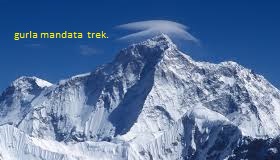Welcome to Gurla Mandata
Mt.Makalu expedition (8,463m).
Mt.Makalu expedition (8,463m). French party first climbed Mt.Makalu in 1955. In the Tibetan side, the peak was mapped and photographed by the British Everest reconnaissance in 1921. Hillary and Ship ton photographed mount Makalu on the 1951 Everest reconnaissance. Hillary and others approached the peak a year later after the failure of their Mt. Cho Oyu expedition.,
The first attempt on Mt.Makalu was in 1954 by a US team, mostly from California. They trekked all the way from the Indian border near Biratnagar. At the same time a British team approached the mountain, when Hillary became seriously ill, this expedition was abandoned and had to be evacuated.,
In the autumn of 1954 a French team attempted the peak. In the following spring, three teams of French climbers successfully made ascents on successive days.,,
The Japanese climbed mount Makalu in 1970. Likewise, another French team climbed it in 1971. And, a Yugoslav expedition reached the summit in 1975.,
Makalu West Face
It is very adventurous route to climb because it is a little bit dangerous as well. Before climbing this Mt.Makalu Mountain people made 5 attempts; then only finally succeeded. The West Face was successfully scaled in 1997.
The Russian expedition had taken the route of this West Face of mount Makalu. Sergey Efimov led and climbed the top on 21st of May via the most difficult route. The last part of the route had gone on Parago ridge. Alexei Bolotov, Yuri Ermachek, Dmitri Pavlenko, Igor Bugachevski and Nikolai Jiline are the person to climb on the top of mount Makalu at this time. For this ascent they got “Gold ice-axe” awarded to them. face book,
SAFETY KITS :
1. You should never trek alone. So, hire a guide if you can’t find companion.
2. Choose trekking companies/guides with eco friendly concepts.
3. Always get information about high altitude sickness.
4. Also, always carry a good medicine kit.
5. Hence, watch where you are walking. And don’t step backward blindly while taking photos.
6. Therefore, time your trek generously. Also, taking rest while trekking is not a sign of weakness.
Therefore, the trip cost will vary depending on the group size, duration of days and services required. Please contact us via our email. gurilamandatatrek@yahoo.com Along with your details to obtain a quote.


